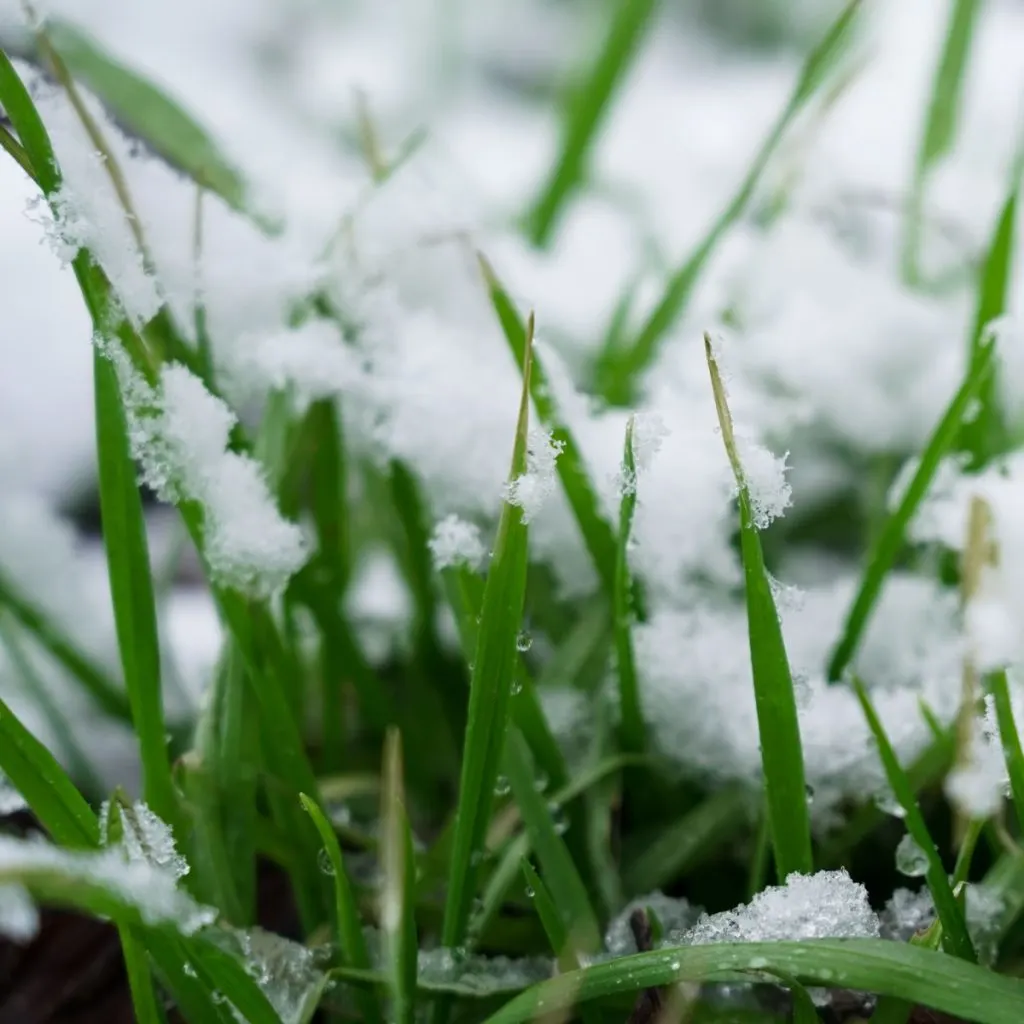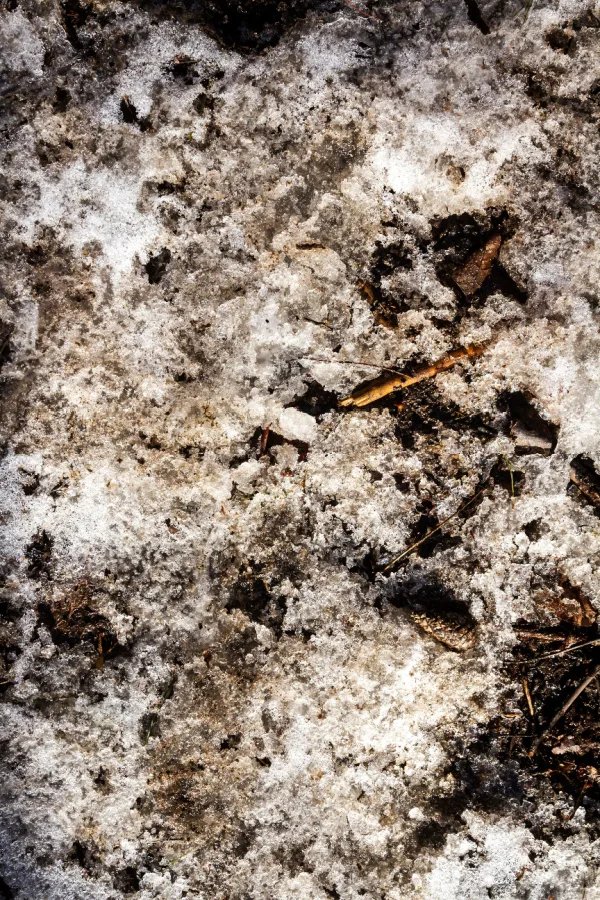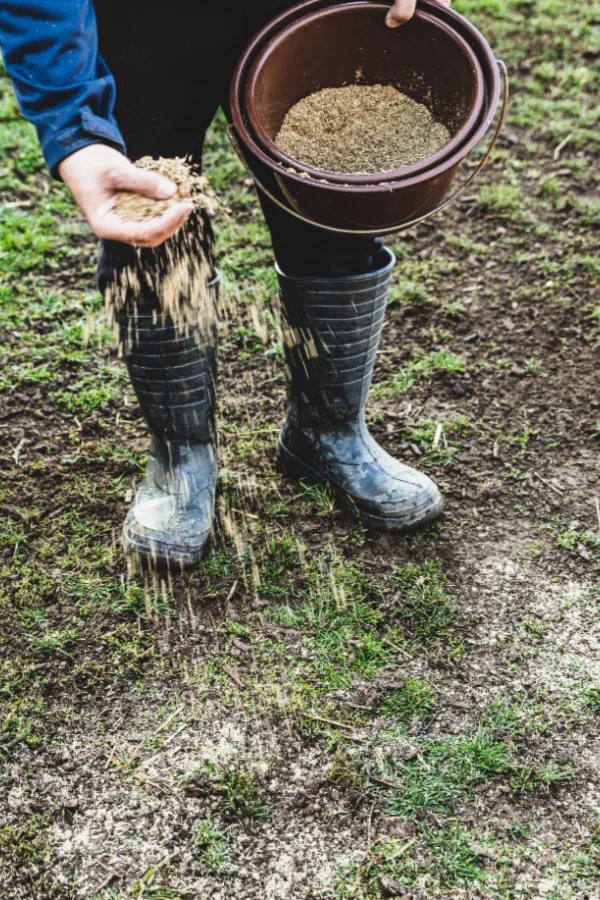Believe it or not – winter is actually one of the easiest and best times of all to overseed your lawn – even when there is snow on the ground. Not only is it incredibly fast and simple to do – it’s also the perfect way to have your lawn thick, green and more lush than ever come next spring – without hardly any work at all on your part!
Many people think grass planting is something reserved for spring or summer, but winter seeding has some surprising advantages. For starters, planting during the colder months can give your lawn a big head start, with new grass sprouting weeks earlier than if you wait until spring to plant.
But the advantages don’t stop there. Winter seeding also simplifies the process by taking advantage of natural weather patterns. That not only can help the grass seed grow easier and faster, but as you will see below, it takes the burden of planting and caring for new grass almost to zero!

Why Winter Overseeding Works So Well
So why is overseeding in the winter so much better? During spring and summer, you often need to water grass seed frequently to ensure it germinates and grows. That’s just not the case in winter. The cold weather and the natural freeze-thaw cycle of the soil does most of that work for you.
But planting in the warm months also involves far more work than just watering. You also need to loosen the soil, whether by raking or tilling. And beyond that, you also have to cover the seed or risk it blowing away or being consumed by animals and pests. The good news? Winter seeding eliminates all of those chores!
How To Overseed Your Lawn In The Winter – The Easy Way To Plant Grass Seed
The Ease & Power Of Overseeding A Lawn In The Winter
Winter seeding, also called dormant seeding, involves spreading grass seed over the soil when temperatures are too low for the seed to germinate. The seeds then remain safe and dormant until the weather warms up in spring.
But here is where the real magic happens, winter weather actually helps plant the seed for you. All because of the soil freezing and thawing – or because of snow melt!
As the soil freezes, it expands, creating tiny cracks and openings. When it thaws, it contracts, pulling the seeds down into the soil. This allows the seeds to settle perfectly without the need for raking or extra effort.

A light snow on the ground can be just as advantageous. The seed melts down into the soil when the snow melts – and right into the soil. Best of all, all of that winter snow and rain during winter provide additional moisture to the seeds, ensuring they will be more than ready to sprout as soon as it starts to warm up in the spring.
Sound easy? It actually is!
How To Overseed Your Lawn In The Winter
Getting The Timing Right
Timing is critical for winter seeding. You need to make sure the seeds stay dormant until spring, so it’s best to wait until temperatures consistently drop below 40°F.
In most regions, this means spreading seed sometime between mid-December up through late February. Seeding too early, when the weather is still mild, will cause the seeds to germinate prematurely. When this happens, the young grass can’t survive the winter freeze.
But by waiting until the temperatures are steady and cold, you will ensure the seeds stay dormant and ready to sprout when the weather warms up.

Choosing The Right Seed – How To Overseed Your Lawn In The Winter
Choosing the right grass seed is also an important step for successful winter seeding. Blended grass seed, which includes multiple varieties, is by far the best choice. Blends are more resilient to disease and drought. They also integrate better with existing lawns compared to single variety seeds.
Cool season grasses and fescue are ideal for winter seeding, as they grow well in cooler climates and germinate quickly when spring arrives. If you’re unsure what type of seed to use, look for one that’s suited for both sunny and shady areas to ensure good coverage. Affiliate Product Link: Jonathan Green Black Beauty Original Grass Seed Blend – Cool Season Lawn Seed
Before you start spreading the seed, take a few minutes to prepare the lawn. If you’re planting on bare soil, begin by clearing away any debris like leaves, sticks, or rocks. Lightly raking the soil will then help create a smooth surface for the seeds.
If the ground is frozen, you can skip the raking step. The natural freeze-thaw cycle will handle the planting for you. When overseeding an existing lawn, it’s helpful to mow the grass short if it wasn’t cut back in the fall. Short grass helps the seed reach the soil more easily, but no worries, if mowing isn’t possible, winter seeding will still work.
Spreading The Seed – How To Overseed Your Lawn In The Winter
Once your lawn is ready, it’s time for spreading the grass seed. For large areas, it’s best to use a broadcast or drop spreader to evenly distribute the seed. For smaller spaces, hand casting the seed works just fine.

Make sure to always follow the recommended seeding rate listed on the seed packaging. Applying too much seed might seem like a good idea, but it can actually harm your lawn by creating overcrowded growth next spring
When there is too much seed, the grass will grow too densely. Unfortunately, the seedlings then compete for water, nutrients, and sunlight, leading to weak and patchy growth as some of the seed is choked out.
Spring Care – How To Overseed Your Lawn In The Winter
As spring approaches and the soil begins to warm, your winter seeded grass will start to grow. Because the seeds have been in the ground all winter, they’ll germinate faster than seeds planted in early spring.
This gives your lawn a head start, allowing it to grow thicker and fuller far faster. To give the young grass an extra boost, apply a slow-release fertilizer in early spring. This provides extra nutrients to support healthy growth and development.
While winter typically provides enough moisture, keep an eye on your lawn during late spring. If the weather becomes dry, occasional watering will help the grass stay strong. Most times, with spring rains, the watering hose is never needed.
It’s important to avoid heavy foot traffic on your lawn while the new grass is establishing itself. The roots of young grass blades are delicate and can be damage or die easily if the lawn has too much traffic.
Here is to using the cold and snow of winter to overseed and thicken your lawn up for next spring! For more great lawn care tips, check out our articles: How To Kill Crabgrass In Late Summer & Fall – 3 Simple Tips To Stop Crabgrass For Good, and 3 Simple Tips & Tricks To A Lush, Green Lawn – With Little Work Or Cost!
This Is My Garden
Follow Our Facebook Page For Great Gardening Tips And Advice! This Is My Garden Facebook Page
This Is My Garden is a garden website created by gardeners, for gardeners. Jim and Mary Competti have been writing gardening, DIY and recipe articles and books and speaking for over 15 years from their 46 acre Ohio farm. They publish three articles every week, 52 weeks a year. Sign up today to follow via email, or follow along!
